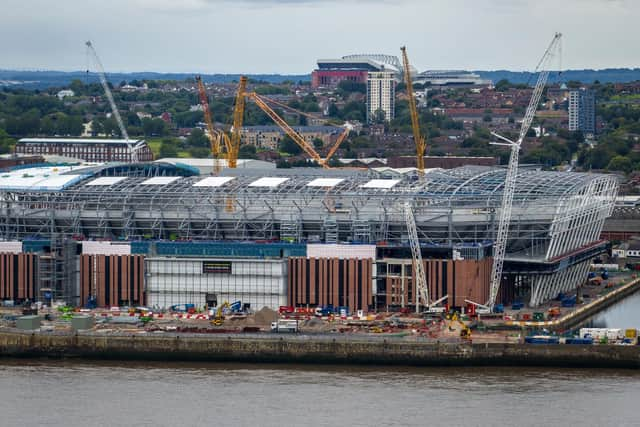World Cup and Euro 2028 announcements underline brazen world of modern football, and it's not good for Yorkshire - Stuart Rayner
Last week it was announced the 2030 World Cup will be co-hosted by a frankly ridiculous six countries across a 6,500-mile spread. This week we had confirmation the 2028 European Championship will be shared between five – England, Wales, Scotland, Northern Ireland and the Republic of Ireland – after political horse-trading once more created a non-contest. Italy and Turkey will share Euro 2032.
The 2034 World Cup hosts are not due to be named for a few weeks but to spare you any tension, it is going to Saudi Arabia. FIFA have more or less made sure of that after the Kingdom opted out of 2030.
Advertisement
Hide AdAdvertisement
Hide AdThe organisation so committed to net zero it is spreading that tournament across South America, Africa and Europe will ignore its self-declared qualms about "white elephants" to visit the footballing hotbed of Saudi Arabia. It will certainly be hot, requiring another winter World Cup. Do not expect much of the 11 years' notice to be spent on co-ordinating the schedule.


How can I be so sure it will be in Saudi?
Well, for starters, FIFA have decided only Asian and Oceania federations can bid. They have given would-be hosts until October 31 to submit a list of 14 stadia, not long at all when the criteria were only published last week, but not such a problem if – like Saudi – you were preparing a 2030 bid.
Almost as soon as the process formally opened, their hat was in the ring.
The rules quietly changed last week to give some leeway. Instead of seven stadia having to already be built, now it is four. That suits Saudi, who started construction on the fourth of their venues for the 2027 Asian Cup last month; three 40,000-plus grounds are being upgraded.
Advertisement
Hide AdAdvertisement
Hide Ad

Australia and New Zealand, the only likely rivals, have 11 suitable stadia and 26 days to plan the rest. It would be a lot easier with vast fortunes of petrodollars and none of the constraints of democracy. Like, you know, Saudi Arabia.
FIFA have a history of clumping bad decisions together. When they famously decided back in 2009 that two World Cup hosts would be named on the same day they awarded the 2018 tournaments to Russia and 2022 to Qatar, not popular with fans of democracy, human rights or the well-being of footballers.
That brought a cleaning of the stables forced by bribery allegations and a string of FBI arrests. If 2023 is a more virtuous process it has not brought better decision-making to FIFA House.
Shamelessly blatant is the way world football's governing body sells itself for votes at FIFA elections. It is why the next World Cup – in Canada, Mexico and the United States – will feature 48 teams in 2026. The how is yet to be worked out.
Advertisement
Hide AdAdvertisement
Hide Ad

More teams means more televised games, more money, more countries needed to host, more national associations on the gravy train, more votes when FIFA president Gianni Infantino stands for re-election promising to look after the whole football family. So he should – the World Cup is not just about Europe and South America – but this is not the right way to go about it. More teams also means more demands on footballers pushed to breaking point by a constant expansion of competing tournaments and less quality. This is not about equality when the rich countries are getting proportionately, as well as actually, richer. If you want the World Cup to get bigger, pump more money into developing players in the smaller countries that will be expected to step up to the plate.
But such is the clash of egos, as FIFA tournaments get bigger with no extra space in the calendar for them, so their European counterparts UEFA respond in kind.
When FIFA is demanding Uruguay, Paraguay, Argentina, Morocco, Spain and Portugal provide 72 training camps between them for a 48-team tournament, you can safely say things have got out of hand.
For the sake of the climate, for the sake of the tournament, for the sake of individual economies, things have to be scaled down.
Advertisement
Hide AdAdvertisement
Hide Ad

That will demand football's power-brokers to be less greedy and willing to start upsetting more people by saying no. Lumping Uruguay, Paraguay and Argentina onto the side of an Iberian-north African tournament is a pretty clear indication that FIFA is not fond of awkward conversations.
In 2028 this largesse will work to Britain and the Republic of Ireland's advantage, just not this corner of it.
The spread of games in a 24-team tournament – Euro 92 had eight – highlights again how Yorkshire is being left behind.
Whereas the north west has so many potential venues that Old Trafford – the now-creaking 2003 Champions League final hosts – and Anfield, where modernity is catching up with history, have not made the cut, Yorkshire has been overlooked.
Advertisement
Hide AdAdvertisement
Hide AdLondon (twice), Cardiff, Manchester, Liverpool (when Everton's new stadium is built), Newcastle, Birmingham, Glasgow, Dublin and Belfast are the chosen cities.
"It is critical the whole country feels they are involved," said the Football Association's chief executive Mark Bullingham, so we may get fanzones or training camps.
This is not a regional newspaper bleating that its cities have been unfairly treated, this is a lament that the United Kingdom's biggest county cannot build and sustain a stadium worthy of consideration.
In 1966 and 1996 – when England hosted major tournaments outright – Sheffield's Hillsborough was a must. The tragedy at the South Yorkshire ground in 1989, plus Premier League money, have transformed English stadia since. For 23 years, Sheffield Wednesday have had none of the latter.
Advertisement
Hide AdAdvertisement
Hide AdLeeds United's Elland Road has masses of atmosphere but its facilities are way down the list by modern standards.
Redeveloping the West Stand is a key part of 49ers Enterprises’ plans for the club but there has been talk for years and very little action. Like Wednesday, they need to be settled in the top flight for that.
Like Elland Road, Sheffield United's Bramall Lane hits Premier League standards but only holds 32,000 (Leeds is nearer 38,000). Politically, Belfast gets the slot for the smallest venue (34,500 when redeveloped) to complete the set of countries and Bramall Lane cannot compete with Villa Park, Eastlands or the stadium being built on Liverpool's Bramley Moore Dock.
Perhaps only Leeds’ Thorp Arch and Middlesbrough’s Rockliffe Park would make the grade as training bases without a lot of work. Boro's Riverside cannot hope to compete with the Stadium of Light, which also missed out, or St James's Park, which did not. Those pesky Saudis again.